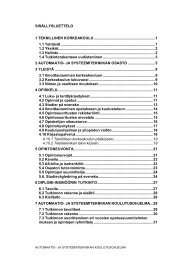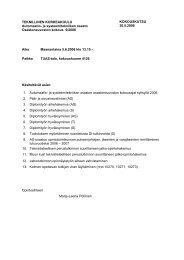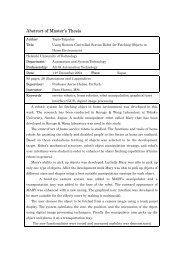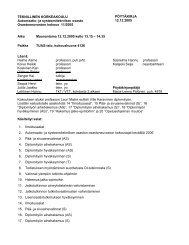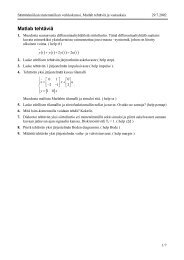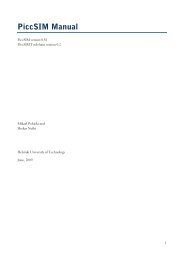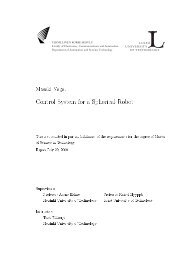fem modelling of a bellows and a bellows- based micromanipulator
fem modelling of a bellows and a bellows- based micromanipulator
fem modelling of a bellows and a bellows- based micromanipulator
You also want an ePaper? Increase the reach of your titles
YUMPU automatically turns print PDFs into web optimized ePapers that Google loves.
FEM <strong>modelling</strong> <strong>of</strong> a <strong>bellows</strong> <strong>and</strong> a <strong>bellows</strong>-<strong>based</strong> <strong>micromanipulator</strong>V. Completion5. COMPLETION5.1 Project conclusions5.1.1 RELIABILITYIn this work, the most observed principle has been mistake forethought. At each phase, stepafter step, any result was carefully checked before proceeding through the next phase. Indeed,a non-negligible part <strong>of</strong> the allowed task duration was devoted to underst<strong>and</strong> the FE methods,in order to select the most fitting elements for each case. Different models were experimentedfor a same problem, so that the results given by different methods compare could becompared.After having chosen the elements, they were checked by setting up three models. Thosevery unlike models were built with completely distinct elements. One was constructed in twodimensioned space with plane element accepting axial symmetry. Another was made <strong>of</strong> 3Dsolid elements, <strong>and</strong> the third composed by shell elements. The theory on which these elementsare <strong>based</strong> differ radically. Hence, if all three results for one corresponding concur, theoutcome is very likely reliable.If two different models are <strong>based</strong> on too similar elements, the way to construct them may beso identical that the same error can be committed in both cases, <strong>and</strong> lead to the identical butfalse answer. On the contrary, if the models are completely unlike, the way to establish themmay also be utterly in contrast, <strong>and</strong> ensure that the same mistake cannot occur in both models.This is actually exactly our case. The way to construct a 2D-model absolutely differs from a3D one. Moreover, solid elements fill a volume-<strong>based</strong> model, but a shell-<strong>based</strong> model can befabricated with areas exclusively. These changed building methods ensure that it is nearlyimpossible that one identical mistake appears in two models, <strong>and</strong> make an accordant resultbeing even more reliable.It is finally to note, that there have been no previous studies <strong>of</strong> this sort <strong>of</strong> microcomponent,which made the simulations <strong>and</strong> <strong>modelling</strong> much harder.5.1.2 BELLOWS' PERFORMANCESThis project showed that the <strong>bellows</strong> has very linear characteristics. Its bending varies in aperfectly proportional fashion to the applied load. Moreover, some parameters are quasiconstantover the full work range <strong>of</strong> the <strong>micromanipulator</strong>. The <strong>bellows</strong>' stiffness varies nomore than 0,002% for bending forces varying from 10 [mN] to 50 [mN].The spring ratio varies a few percentages when applying varying compressing or elongatingloads. But even then, it varies in a very linear way, <strong>and</strong> can easily be taken into account forthe open-loop control, if necessary.The axial expansion <strong>of</strong> the <strong>bellows</strong> when applying interior pressure also varies less than0,3% over the full pressure range, <strong>and</strong> in an entirely linear way.Finally, it can be concluded that the high linearity <strong>of</strong> the <strong>bellows</strong>' motion constitute anexcellent connection between the piezoactuators <strong>and</strong> the end-effector, <strong>and</strong> that it can improvea new type <strong>of</strong> accurate join-free parallel structure, where the joints are integrated into theactuation links.Furthermore, once the geometrical parameters exactly checked for each <strong>bellows</strong> through anelementary calibration method, <strong>and</strong> the kinematic precisely adapted, the open-loop control <strong>of</strong>43



